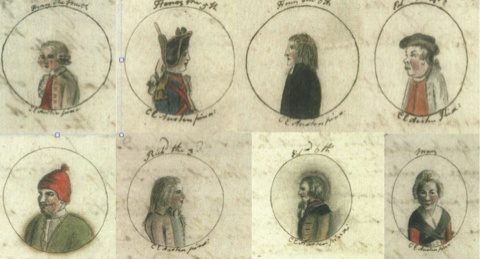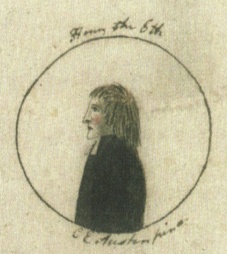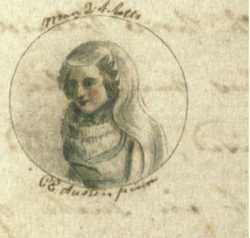Today, Olga Palagina shares with us her amazing research on Jane Austen’s fun juvenilia The History of England, and the collaboration between Jane and her sister, Cassandra. Thank you so much, Olga, for sharing your time and knowledge with us!
At a first glance, ‘The History of England’ appears to be an amusing piece used by the sixteen year old Jane Austen to criticise historians of her day for their construction of historical narrative, defend her favourite historical figure Mary Stuart Queen of Scotland, and profess her own political opinions as a young woman. However, on closer inspection, it is not only Austen’s work but also that of her sister Cassandra.
Jane Austen’s close relationship with her sister and its important role in her life has been noted by many. For example, in his book, What Matters in Jane Austen, John Muller dedicates a whole chapter to the discussion of the closeness between the two sisters and the various portrayals of the sisterly bond in Austen’s novels. Despite the arguments and countless studies, the reflection of this sisterly bond between the two Austen sisters in Jane’s juvenile work has for the most part been overlooked. Although in The Real Jane Austen Paula Byrne does acknowledge Cassandra’s illustrations of monarchs in Jane’s ‘The History of England’, she quickly moves on to argue that the ‘History’ was more of a family project. However, out of all of Austen’s juvenile work, it is ‘The History of England’ that cannot be entirely regarded as a piece entirely belonging to the young Jane Austen. While the words may be hers, the illustrations by her sister provide an additional layer of meaning behind this piece. As such it is a project between two sisters and a wonderful example demonstrating their close bond that had already emerged before adulthood.

From top left to bottom right, Cassandra’s illustrations of Henry IV, Henry V, Henry VI, Edward IV, Henry VIII, Richard III, Edward VI and Queen Mary.
Byrne’s argument that Cassandra’s illustrations in ‘History’ respond to Jane’s narrative is to some extent well founded. For example, throughout this piece, Austen emphasises her unwavering support for the York and Stuart monarchs. This support is clearly demonstrated in Cassandra’s illustrations as all Tudor monarchs, excluding Edward VI, are drawn either as people of lower rank or arrogant and repulsive. For example, Edward IV is drawn as a vile ugly pig farmer, Henry VII is a pauper, Henry VIII a merchant of sorts from a lower rank, Mary I an elderly lower class woman and Elizabeth an arrogant witch in a disguise of an aristocratic lady.

Illustrations from left to right: Edward IV, Henry VII, Henry VIII, Mary I and Elizabeth I
Jane Austen’s low regard and emphasis on their detestable personalities and crimes are all clearly summarised in her sister’s illustrations. Austen’s admiration and high opinion of the Stuarts is similarly demonstrated in the illustrations as Cassandra drew all of the male monarchs in the images of rich gentlemen, while Mary Queen of Scotland, the heroine of the piece, is drawn almost as a saintly figure. In short, Cassandra’s illustrations summarise Austen’s opinions of each monarch.

Illustrations from left to right: James I, Charles I and Mary Queen of Scotland
Cassandra’s illustrations are responsive to Jane’s words in another sense due to their clarification of the points the younger of the two sisters makes. For example, Austen’s sarcasm in her comment regarding the fame of Edward IV’s beauty is clarified in an illustration of him as an ugly pig farmer. Jane’s reference to the illustration: ‘the Picture we have given of him’ is a clear demonstration of the sisters’ joint effort in the construction of this piece.

Edward IV
Similarly, Cassandra responds to Jane’s comment about the brevity of Edward V reign leaving no time for ‘his picture’ to be created by making him the only monarch in ‘The History of England’ to not have an accompanying illustration. By clarifying points her sister makes about certain monarchs in her ‘History’, Cassandra’s illustrations are responses to her sister’s words.

Henry VI
However, in addition to clarifying and supporting her sister’s narrative, Cassandra’s illustrations add further information about some of the monarchs. For example, in her section concerned with Henry VI, the majority of Austen’s narrative is concerned with the Wars of the Roses without a mention of this monarch’s devotion to religion and education.
It is Cassandra Austen’s illustration of this monarch, drawn in the clothes of a clergyman, that supplies this information. Similarly, while Henry V is famous for his military successes even before he became the king of England, Jane Austen’s only mention to the military in regards to this monarch is the Battle of Agincourt victory. Once again, it is Cassandra’s illustration of Henry in the military uniform which is used as additional information about this monarch’s life.

Henry V
It could be argued that additionally to supplying further information about the monarchs, while her sister was using words to tackle history and the construction of historical narrative, Cassandra used her illustrations to demonstrate her own opinions and knowledge about history. Her illustrations thus demonstrate that while Jane was responsible for the narrative, ‘The History of England’ was in reality a project shared by two sisters.
In her argument that ‘The History of England’ was more of a family project, Paula Byrne proposes the idea that Cassandra’s illustration of Mary Queen of Scotland was really a miniature portrait of the young Jane Austen. If this is true, then the illustration can be regarded as Cassandra’s personal touch on the ‘History of England’ and a touching example of the close relationship between the two sisters.

Mary Queen of Scotland
Throughout the narrative of the piece, Jane’s love for Mary Stuart is constantly emphasised. In the section concerning Henry VII, Jane notes that his eldest daughter ‘had the happiness’ of being the grandmother of ‘one of the first Characters in the world’. Similarly, it is amusing to note that the section regarding Elizabeth I is predominantly used to criticise her and her government for their treatment and eventual execution of Mary Stuart. By the end of the last section in the narrative, concerned with Charles I, Jane confesses that her whole purpose in writing the ‘History’ was ‘to prove the innocence of the Queen of Scotland’. Thus, if Byrne’s theory is correct and Cassandra’s illustration of this favourite monarch is indeed a portrait of Jane, then by drawing her sister’s favourite monarch in the image of her, Cassandra was linking the two together and in doing so voiced her love and support for her sister. It is a touching gesture and one that should not be overlooked!
Cassandra’s illustrations were not merely supporting material for her sister’s narrative in ‘The History of England’. While they did support, and at times clarify, her sister’s information and opinions regarding each monarch, they also provided additional information and opinions from Cassandra herself. Where Jane used words, Cassandra’s illustrations acted as her own words within the narrative. The words of one sister and the illustrations of the other thus formed a narrative of two voices that became ‘The History of England’. This piece is truly remarkable is all of Jane’s juvenile work. However, while the other pieces in the three volumes of the Juvenilia were entirely the creations of the young Jane Austen, ‘The History of England’ was truly a project shared by two sisters.

About Olga Palagina:
Jane Austen entered my life in the summer of 2006, when my English teacher told me that Pride and Prejudice was the chosen exam text for my English Literature GCSE. I remember very clearly watching a short film about her life and being assigned a research project about this author’s life and work as homework for the summer. If I had known that Austen would help me improve my English vocabulary and her work would give me so much joy, perhaps at the start of my research that summer I would have been more excited than nervous! However, as I began my research, I fell in love with the Austen family and the world they lived in. This developed further once I studied Pride and Prejudice and I went on to read Austen’s other work as well as the vast literature written about her and her novels. All of this led to Jane Austen becoming my favourite writer! As both a history enthusiast and a person born in another country, I owe much to Austen and her work. It extended my English vocabulary, which in turn improved my oral and written communication skills. At the same time my curiosity for the world Austen wrote about has opened my eyes to the importance of literature in history. After school, I completed a Joint Honours History and Sociology Degree and a Masters in History at the University of Warwick. On 1st September 2016, I will be embarking on a PGCE course and train to become a History Teacher. No matter what is ahead for me, Jane Austen will always have a big part in my life!
Works used:
Jane Austen and Kathryn Sutherland (introduction and editor), Volume The Second In Her Own Hand (2014)
Paula Byrne, The Real Jane Austen: A Life In Small Things (2013)
John Mullan, What Matters In Jane Austen?: Twenty Crucial Puzzles Solved (2012)

11 comments
Skip to comment form
Fascinating and really well written, Olga! I have both John Mullan’s and Paula Byrne’s books, but had not made the connections you had, so I really enjoyed this.
Your command of English is fantastic (living in a foreign country, I know how hard it is to master another tongue!). I wish you much enjoyment and great success for your new era of studies and a wonderful future as a teacher of history. Your future students will be very very fortunate!
Aww thank you very much!! It was so much fun to research and write this, so I am glad you enjoyed reading the blog post! I love both Mullan’s and Byrne’s books. They are wonderful resources 🙂
In terms of the year ahead, thank you for the good luck wishes. We shall see what happens. I will keep you posted …
Good luck to both you and Ada with the sequel to The Particular Charm of Miss Jane Austen! I can’t wait what the two of you will write next. You are a fantastic team 🙂
xx
Author
I know I told you this before I set it up, but I love this, Olga! I’ve read History of England, but never paid such close attention to the artwork before. You’ve opened my eyes. Thanks so much for sharing with us! 🙂
Wonderful post! Also of interest is the Juvenilia Press’s edition of The History of England in which Christine Alexander and Annette Upfal theorize that most of the portraits Cassandra drew represent friends and family members – in particular, Mrs. Austen as Queen Elizabeth! It’s a fascinating book, and here are a couple of articles about it:
http://www.jasna.org/persuasions/on-line/vol30no2/upfal-alexander.html
https://www.researchgate.net/publication/236814851_Jane_Austen's_The_History_of_England_Cassandra's_Portraits_review
Thank you so much for the information, Olga. This is very intersting. When I finally read Jane’s Juvenalia I will look at her History of England in a different light and look closely at the pictures. This was so enjoyable.
What interesting and original writing. Thank you!
Thanks so much for the wonderful post, Olga! I read Austen’s History of England a few months ago and now want to go back and read it again!
Absolutely loved this, Olga! The insights into Jane’s opinions of the various monarchs as shown through Cassandra’s illustrations is completely new to me, and I always love learning something new about my favorite novelist. Thank you so much!!
Warmly,
Susanne 🙂
Very interesting. I didn’t know about Jane Austen’s fondness for Mary Queen of Scots, especially as she was the daughter of a Protestant clergyman. If Mary had succeeded to the English throne, she most certainly would have pushed for the restoration of the Catholic religion as the official religion(and we know how well that went under Mary Tudor). I loved all the drawings. Thanks for sharing.
I have both Mullan’s and Byrne’s books as well. Now if I could only convince DD’s freshman lit teacher that Austen did not write “chick lit”! Thank you for the insight! Congratulations on you command of English and it’s influence on your career.
This was an interesting article. I especially liked learning about the illustrations since they only earned a glance before. Thank you for your work and for sharing.